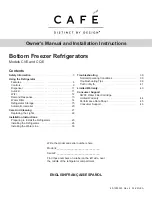
36
How to save energy
The colder the ambient temperature of the appliance
is the less energy it uses.
Avoid putting the appliance in a sunny place and near
anything that gives off heat.
Be sure that the condenser and the compressor are
well ventilated. Do not cover the sections where ven-
tilation is.
Wrap products in tightly closing dishes or cling film to
avoid building up unnecessary frost.
Do not leave the door open longer than necessary
and avoid unnecessary openings.
Put foods into the appliance only in a closed dish.
Put warm foods into the appliance only when they are
at room temperature.
Keep the condenser clean at the back of the appli-
ance.
The appliance and environment
This appliance does not contain gasses which
could damage the ozone layer, in either its refrigerant cir-
cuit or insulation materials. The appliance shall not be dis-
carded together with the urban refuse and rubbish. Avoid
damaging the cooling unit, especially at the rear near the
heat exchanger. Information on your local disposal sites
may be obtained from your municipal authorities.
The materials used on this appliance marked with the sym-
pol are
recyclable.
Maintenance
Defrosting
Bleeding part of the moisture of cooling chamber in form
of frost and ice goes with the operation of the refrigerator.
Thick frost and ice has an insulating effect, so it reduces
cooling efficiency as the temperature increases and it
needs more energy.
At this type of appliance defrosting cooling compartment
is automatic without any external intervention.
The thermostatic control interrupts the operation of com-
pressor at regular intervals for more or less time - during
this cooling is interrupted - temperature of the cooling
compartment increases and defrosting occurs. After
defrosting the thermostatic control restarts operation of
the system.
Melting water flows through defrost water outlet into the
evaporative tray maintained on the top of compressor and
evaporates due to warmth of it.
Check and clean the outlet of melting water
coming during defrosting regularly. If it is
clogged the melting water gathered can
cause earlier failure as it can go to the insulating of
the appliance.
Clean the melting water outlet with the supplied pipe
scraper that can be seen in the figure. The pipe scraper
has to be stored in the outlet.
Occasionally check the defrost water outlet not to be
clogged up.
The most typical case of clogging up in the defrost water
outlet when you put food wrapped in some paper into the
appliance and this paper contacts back plate of cooling
compartment and freezes to it. If you remove the food right
at this moment the paper will tear and it can cause clogging
up in the outlet by getting into it. So you are asked to be
careful - because of the above - when placing foods
wrapped in paper into the appliance.
In case of increased demand e.g. during heat-
waves, the refrigerator temporarily happens to
operate constantly - during this the automatic
defrosting is ineffective.
Remaining small ice and frost stains on back plate of the
cooling compartment after defrosting period is not abnor-
mal.
Regular cleaning
It is recommended to wash the inside of the refrigerator in
3-4 weeks time.
Household cleaner or soap must not be used.
After you made it no-current wash the appliance using luke-
warm water and wipe it.
Clean the magnet door rubber profile with clean water.
After cleaning plug the appliance to the mains socket.
Dust and dirt collected on the back of the refrigerator, con-
denser is recommended to be removed and clean the
evaporative tray on top of the compressor once or twice a
year.
GB









































